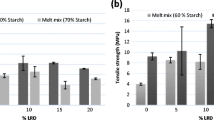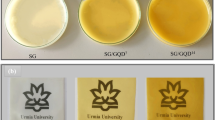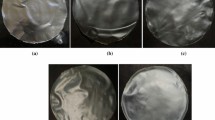Abstract
The research encompasses on a comparative study of biodegradable membranes based on poly(vinyl alcohol) (PVA), starch (St), graphene oxide (GO) and reduced graphene oxide (rGO) for food packaging application. Four different concentrations, i.e., 10, 20, 30 and 40 mg, of GO and rGO were incorporated in membranes using in situ and ex situ reduction technique. The aim was to enhance the antibacterial and mechanical properties of PVA/St membranes. PVA/St membranes having 20 mg of in situ reduced graphene oxide (PVA/St/IrGO20) exhibited an exceptional tensile strength of 22.719 MPa and outstanding antibacterial activity, i.e., 38.89 ± 0.23 mm and 37.52 ± 0.41 mm, against Escherichia coli and Methicillin-resistant Staphylococcus aureus, respectively. The membranes were also analyzed by scanning electron microscopy (SEM), X-ray diffraction, Fourier transform infrared spectroscopy (FTIR) and thermogravimetric analysis (TGA). SEM results revealed the dense morphology for all membranes. FTIR results displayed the successful synthesis of GO, rGO and nanocomposite membranes. The TGA showed that IrGO membranes were more stable as compared to neat and graphene oxide membranes. Moreover, the membranes degraded completely after being buried in the soil. Among all the synthesized membranes, PVA/St/IrGO20 and PVA/St/XrGO10 (PVA/St containing 10 mg ex situ reduced GO) exhibited excellent barrier against water vapor and oxygen transmission. Therefore, they prolonged the shelf life of packed gooseberries as compared to all formulated membranes.
Graphic abstract









Similar content being viewed by others
References
Jassim AK (2017) Open access peer-reviewed chapter. Sustainable solid waste recycling. https://doi.org/10.5772/intechopen.70046
Rahman AR, Syamsu KS, Isroi II (2019) Biodegradability of bioplastic in natural environment. J Pengelolaan Sumberd Alam dan Lingkung (J Nat Resour Environ Manag) 9:258–263
Han JH (2014) Chapter 1-a review of food packaging technologies and innovations. In: Han JH (ed) Innovations in food packaging, 2nd edn. Academic Press, San Diego, pp 3–12
Sam S, Mohd Amer N, Chin KM, Hani N (2016) Current application and challenges on packaging industry based on natural polymer Blendin. Springer, New York, pp 163–184
Abdullah ZW, Dong Y, Davies IJ, Barbhuiya S (2017) PVA, PVA blends, and their nanocomposites for biodegradable packaging application. Polym Plast Technol Eng 56:1307–1344
Yuan P (2015) Properties and applications of halloysite nanotubes: recent research advances and future prospects. Appl Clay Sci 112–113:75–93
Yu Z, Li B, Chu J, Zhang P (2017) Silica in situ enhanced PVA/chitosan biodegradable films for food packages. Carbohydr Polym 184:214–220
Ismail H, Zaaba NF (2011) Effect of additives on properties of polyvinyl alcohol (PVA)/tapioca starch biodegradable films. Polym Plast Technol Eng 50:1214–1219
Yoon S-D, Park M-H, Byun H-S (2012) Mechanical and water barrier properties of starch/PVA composite films by adding nano-sized poly(methyl methacrylate-co-acrylamide) particles. Carbohydr Polym 87:676–686
Lu DR, Xiao CM, Xu SJ (2009) Starch-based completely biodegradable polymer materials. Express Polym Lett 3:366–375
Karaoğul E, Altuntaş E, Salan T, Hakki M (2018) The effects of novel additives used in PVA/starch biohybrid films. IntechOpen, London
Flores S, Haedo AS, Campos C, Gerschenson L (2007) Antimicrobial performance of potassium sorbate supported in tapioca starch edible films. Eur Food Res Technol 225:375–384
Ali AS (2020) Application of nanomaterials in environmental improvement. IntechOpen, London
Khan HA, Sakharkar MK, Nayak A, Kishore U, Khan A (2018) 14 - Nanoparticles for biomedical applications: an overview. In: Narayan R (ed) Nanobiomaterials. Woodhead Publishing, Cmabridge, pp 357–384
Singh NA (2017) Nanotechnology innovations, industrial applications and patents. Environ Chem Lett 15:185–191
Ahmed HB, Emam HE (2021) Overview for multimetallic nanostructures with biomedical, environmental and industrial applications. J Mol Liq 321:114669
Ghosh S, Jijil CP, Devi R (2012) In situ encapsulation of ultra small ceria nanoparticles stable at high temperatures in the channels of mesoporous silica. Microporous Mesoporous Mater 155:215–219
Dzhardimalieva GI, Uflyand IE (2018) Preparation of metal-polymer nanocomposites by chemical reduction of metal ions: functions of polymer matrices. J Polym Res 25:255
Sharma C, Dhiman R, Rokana N, Panwar H (2017) Nanotechnology: an untapped resource for food packaging. Front Microbiol 8:1735–1735
Ahmed HB, Attia MA, El-Dars FMSE, Emam HE (2019) Hydroxyethyl cellulose for spontaneous synthesis of antipathogenic nanostructures: (Ag & Au) nanoparticles versus Ag-Au nano-alloy. Int J Biol Macromol 128:214–229
Ahmed HB, Emam HE (2020) Seeded growth core-shell (Ag–Au–Pd) ternary nanostructure at room temperature for potential water treatment. Polym Test 89:106720
Ahmed HB, Mikhail MM, El-Sherbiny S, Nagy KS, Emam HE (2020) pH responsive intelligent nano-engineer of nanostructures applicable for discoloration of reactive dyes. J Colloid Interface Sci 561:147–161
Emam HE, Saad NM, Abdallah AEM, Ahmed HB (2020) Acacia gum versus pectin in fabrication of catalytically active palladium nanoparticles for dye discoloration. Int J Biol Macromol 156:829–840
Biswas S, Panja SS, Bose S (2018) Tailored distribution of nanoparticles in bi-phasic polymeric blends as emerging materials for suppressing electromagnetic radiation: challenges and prospects. J Mater Chem C 6:3120–3142
Ma J, Li Y, Yin X, Xu Y, Yue J, Bao J et al (2016) Poly(vinyl alcohol)/graphene oxide nanocomposites prepared by in situ polymerization with enhanced mechanical properties and water vapor barrier properties. RSC Adv 6:49448–49458
De Silva KKH, Huang HH, Joshi RK, Yoshimura M (2017) Chemical reduction of graphene oxide using green reductants. Carbon 119:190–199
Surudžić R, Janković A, Mitrić M, Matić I, Juranić ZD, Živković L et al (2016) The effect of graphene loading on mechanical, thermal and biological properties of poly(vinyl alcohol)/graphene nanocomposites. J Ind Eng Chem 34:250–257
Sundramoorthy A, Kumar TH, Gunasekaran S (2018) Graphene-based nanosensors and smart food packaging systems for food safety and quality monitoring. Elsevier, Amsterdam, pp 267–306
Yin B, Wang J, Jia H, He J, Zhang X, Xu Z (2016) Enhanced mechanical properties and thermal conductivity of styrene–butadiene rubber reinforced with polyvinylpyrrolidone-modified graphene oxide. J Mater Sci 51:5724–5737
Marcano DC, Kosynkin DV, Berlin JM, Sinitskii A, Sun Z, Slesarev A et al (2010) Improved synthesis of graphene oxide. ACS Nano 4:4806–4814
Alam SN, Sharma N, Kumar L (2017) Synthesis of Graphene Oxide (GO) by Modified Hummers Method and Its Thermal Reduction to Obtain Reduced Graphene Oxide (rGO)*. Graphene 06:1–18
Sarwar MS, Niazi M, Jahan Z, Ahmad T, Hussain A (2018) Preparation and characterization of PVA/nanocellulose/Ag nanocomposite films for antimicrobial food packaging. Carbohydr Polym 184:453–464
Boonkaew B, Suwanpreuksa P, Cuttle L, Barber PM, Supaphol P (2014) Hydrogels containing silver nanoparticles for burn wounds show antimicrobial activity without cytotoxicity. J Appl Polym Sci 131(131):40215
Winkler LW (1888) Die Bestimmung des im Wasser gelösten Sauerstoffes. Ber der dtsch chem Ges 21:2843–2854
Wittaya-areekul S, Prahsarn C (2006) Development and in vitro evaluation of chitosan-polysaccharides composite wound dressings. Int J Pharm 313:123–128
Irshad S, Mahmood M, Perveen F (2012) In vitro antibacterial activities of three medicinal plants using agar well diffusion method Research. J Biol 2:1–8
Martucci JF, Ruseckaite RA (2015) Biodegradation behavior of three-layer sheets based on gelatin and poly (lactic acid) buried under indoor soil conditions. Polym Degrad Stab 116:36–44
Neena Gautam IK (2013) Soil burial biodegradation studies of starch grafted polyethylene and identification of Rhizobium meliloti therefrom. J Environ Chem Ecotoxicol 5(6):147–158
Abdullah ZW, Dong Y, Han N, Liu S (2019) Water and gas barrier properties of polyvinyl alcohol (PVA)/starch (ST)/ glycerol (GL)/halloysite nanotube (HNT) bionanocomposite films: experimental characterisation and modelling approach. Compos B Eng 174:107033
Kirubasankar B, Murugadoss V, Lin J, Dong M, Zhang J-X, Li T et al (2018) In situ grown nickel selenide on graphene nanohybrid electrodes for high energy density asymmetric supercapacitors. Nanoscale 10:20414–20425
Deng S, Berry V (2016) Wrinkled, rippled and crumpled graphene: an overview of formation mechanism, electronic properties, and applications. Mater Today 19:197–212
Hassan A, Niazi M, Hussain A, Farrukh S, Ahmad T (2017) Development of anti-bacterial PVA/starch based hydrogel membrane for wound dressing. J Polym Environ 26(1):235–243
Liu H, Kuila T, Kim NH, Ku B-C, Lee JH (2013) In situ synthesis of the reduced graphene oxide–polyethyleneimine composite and its gas barrier properties. J Mater Chem A 1:3739–3746
Mural PKS, Sharma M, Madras G, Bose S (2015) A critical review on in situ reduction of graphene oxide during preparation of conducting polymeric nanocomposites. RSC Adv 5:32078–32087
Strankowski M, Piszczyk Ł, Kosmela P, Korzeniewski P (2015) Morphology and the physical and thermal properties of thermoplastic polyurethane reinforced with thermally reduced graphene oxide. Pol J Chem Technol 17:88–94
Shojaeenezhad SS, Farbod M, Kazeminezhad I (2017) Effects of initial graphite particle size and shape on oxidation time in graphene oxide prepared by Hummers’ method. J Sci Adv Mater Devices 2:470–475
Jiao X, Qiu Y, Zhang L, Zhang X (2017) Comparison of the characteristic properties of reduced graphene oxides synthesized from natural graphites with different graphitization degrees. RSC Adv 7:52337–52344
Wang G, Yang J, Park J, Gou X, Wang B, Liu H et al (2008) Facile synthesis and characterization of graphene nanosheets. J Phys Chem C 112:8192–8195
Luo L, Peng T, Yuan M, Sun H, Dai S, Wang L (2018) Preparation of graphite oxide containing different oxygen-containing functional groups and the study of ammonia gas sensitivity. Sensors (Basel, Switzerland) 18:3745
Tuz Johra F, Lee J, Jung W-G (2014) Facile and safe graphene preparation on solution based platform. J Ind Eng Chem 20:2883–2887
Schniepp HC, Li J-L, McAllister MJ, Sai H, Herrera-Alonso M, Adamson DH et al (2006) Functionalized single graphene sheets derived from splitting graphite oxide. J Phys Chem B 110:8535–8539
Loryuenyong V, Totepvimarn K, Eimburanapravat P, Boonchompoo W, Buasri A (2013) Preparation and characterization of reduced graphene oxide sheets via water-based exfoliation and reduction methods. Adv Mater Sci Eng 2013:5
Shalaby A, Nihtianova D, Markov P, Staneva A, Iordanova R, Dimitriev Y (2015) Structural analysis of reduced graphene oxide by transmission electron microscopy. Bulg Cheml Commun 47:291–295
Kim HM, Lee JK, Lee HS (2011) Transparent and high gas barrier films based on poly(vinyl alcohol)/graphene oxide composites. Thin Solid Films 519:7766–7771
Usman A, Hussain Z, Riaz A, Khan AN (2016) Enhanced mechanical, thermal and antimicrobial properties of poly(vinyl alcohol)/graphene oxide/starch/silver nanocomposites films. Carbohydr Polym 153:592–599
Cheng HK, Sahoo NG, Tan YP, Pan Y, Bao H, Li L et al (2012) Poly(vinyl alcohol) nanocomposites filled with poly(vinyl alcohol)-grafted graphene oxide. ACS Appl Mater Interfaces 4:2387–2394
Minitha CR, Anithaa VS, Subramaniam V, Rajendra Kumar RT (2018) Impact of oxygen functional groups on reduced graphene oxide-based sensors for ammonia and toluene detection at room temperature. ACS Omega 3:4105–4112
Gupta B, Kumar N, Panda K, Kanan V, Joshi S, Visoly-Fisher I (2017) Role of oxygen functional groups in reduced graphene oxide for lubrication. Sci Rep 7:45030–45030
Wolkers WF, Oliver AE, Tablin F, Crowe JH (2004) A Fourier-transform infrared spectroscopy study of sugar glasses. Carbohydr Res 339:1077–1085
Sedaghat E, Rostami AA, Ghaemy M, Rostami A (2018) Characterization, thermal degradation kinetics, and morphological properties of a graphene oxide/poly (vinyl alcohol)/starch nanocomposite. J Therm Anal Calorim 136:759–769
Conte A, Angiolillo L, Mastromatteo M, Del Nobile MA (2013) Technological options of packaging to control food quality. Intech, London
Loryuenyong V, Saewong C, Aranchaiya C, Buasri A (2015) The improvement in mechanical and barrier properties of poly(Vinyl Alcohol)/graphene oxide packaging films. Packag Technol Sci 28:939–947
Tolinski M (2015) Gas barrier properties enhancement. Elsevier, Amsterdam, pp 171–173
Lu G, Ling K, Zhao P, Xu Z, Deng C, Zheng H et al (2010) A novel in situ-formed hydrogel wound dressing by the photocross-linking of a chitosan derivative. Wound Repair Regen 18:70–79
Müller K, Bugnicourt E, Latorre M, Jorda Beneyto M, Sanz Y, Lagaron JM et al (2017) Review on the processing and properties of polymer nanocomposites and nanocoatings and their applications in the packaging, automotive and solar energy fields. Nanomaterials 7:47
Singh B, Pal L (2012) Sterculia crosslinked PVA and PVA-poly(AAm) hydrogel wound dressings for slow drug delivery: mechanical, mucoadhesive, biocompatible and permeability properties. J Mech Behav Biomed Mater 9:9–21
Malhotra B, Keshwani A, Kharkwal H (2015) Antimicrobial food packaging: potential and pitfalls. Front Microbiol 6:611–611
Szunerits S, Boukherroub R (2016) Antibacterial activity of graphene-based materials. J Mater Chem B 4:6892–6912
Akhavan O, Ghaderi E (2010) Toxicity of graphene and graphene oxide nanowalls against bacteria. ACS Nano 4:5731–5736
Sengupta I, Bhattacharya P, Talukdar M, Neogi S, Pal SK, Chakraborty S (2019) Bactericidal effect of graphene oxide and reduced graphene oxide: Influence of shape of bacteria. Colloid Interface Sci Commun 28:60–68
Kumar P, Huo P, Zhang R, Liu B (2019) Antibacterial properties of graphene-based nanomaterials. Nanomaterials (Basel) 9:737
Li X, Li F, Gao Z, Fang L (2015) Toxicology of graphene oxide nanosheets against paecilomyces catenlannulatus. Bull Environ Contam Toxicol 95:25–30
Liu S, Zeng TH, Hofmann M, Burcombe E, Wei J, Jiang R et al (2011) Antibacterial activity of graphite, graphite oxide, graphene oxide, and reduced graphene oxide: membrane and oxidative stress. ACS Nano 5:6971–6980
Zarei A, Ghaffarian V (2013) Preparation and characterization of biodegradable cellulose acetate-starch membrane. Polym-Plast Technol Eng 52:387–392
Acknowledgements
This study was supported by the National University of Sciences and Technology (NUST), Islamabad, Pakistan.
Author information
Authors and Affiliations
Corresponding author
Ethics declarations
Conflict of interest
There is no conflict of interest statement in the manuscript.
Additional information
Publisher's Note
Springer Nature remains neutral with regard to jurisdictional claims in published maps and institutional affiliations.
Rights and permissions
About this article
Cite this article
Iqbal, M., Niazi, M.B.K., Jahan, Z. et al. Fabrication and characterization of carbon-based nanocomposite membranes for packaging application. Polym. Bull. 79, 5019–5040 (2022). https://doi.org/10.1007/s00289-021-03763-1
Received:
Revised:
Accepted:
Published:
Issue Date:
DOI: https://doi.org/10.1007/s00289-021-03763-1




